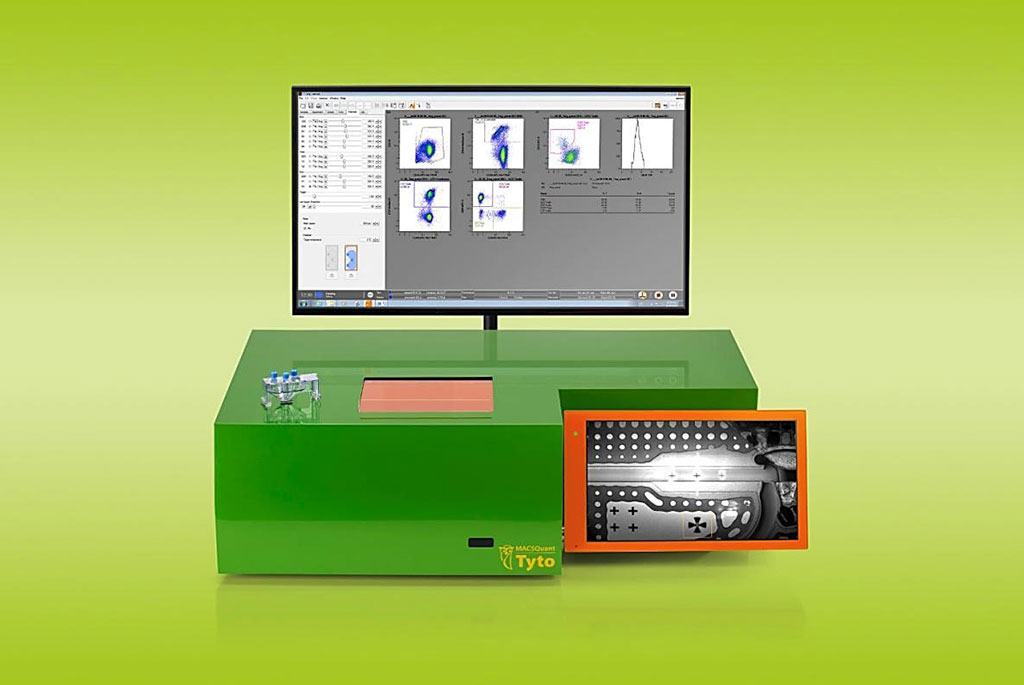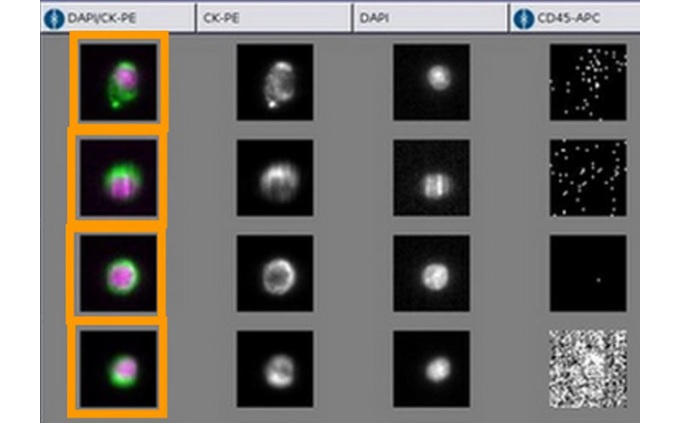Benchtop Cell Sorter Validated in Biosafety Containment Setting
|
By LabMedica International staff writers Posted on 27 Dec 2021 |

Image: The MACSQuant Tyto Cell Sorter can be used safely in at BSL-3 laboratory facilities (Photo courtesy of Miltenyi Biotec)
Fluorescent-activated cell sorting (FACS) is often the most appropriate technique to obtain pure populations of a cell type of interest for downstream analysis. The ability to sort pure populations of immune cells is a critical tool for immunologists.
Aerosol droplets can be generated during the sort, which poses a biosafety risk when working with samples containing risk group 3 pathogens such as Francisella tularensis, Mycobacterium tuberculosis, Yersinia pestis, and severe acute respiratory syndrome coronavirus 2.
Pulmonary pathogen specialists at the Rocky Mountain Laboratories (Hamilton, MT, USA) performed aerosol testing as part of the biosafety evaluation of the MACSQuant Tyto (Miltenyi Biotec, Bergisch Gladbach, Germany) a completely closed, cartridge-based cell sorter. They also established quality control procedures to routinely evaluate instrument performance. Aerosol testing was performed on FACSAria II (BD Biosciences, San Diego, CA, USA) with the Aerosol Management System disabled as a positive control for aerosol generation.
The scientists reported that before usage of the Tyto on the benchtop to sort cells at BSL-3, it was necessary to empirically determine if aerosols were generated during the cell sort procedure. They utilized a novel method using internally fluorescent 1.0 μm beads to perform aerosol testing on the Tyto. These beads were uniform in size and intensely fluorescent in the fluorescein isothiocyanate (FITC) channel.
As a positive control, they detected aerosols generated by the in-house FACSAria II when the Aerosol Management System was disabled, and the flow stream disrupted. As expected, beads were detected on the coverslip after only a 30-second exposure. The MACSQuant Tyto did not produce aerosols as part of the sort procedure. The scientists established a purity of >96%, depletion yield of >80%, and sort efficiency of >85% as benchmarks that must be met during quality control testing.
The authors concluded that they utilized the Tyto cell sorter in their BSL-3 laboratory. This instrument not only has a small footprint but most importantly does not generate aerosols during the sort procedure. The use of this technology will improve current immunological studies in containment laboratories by allowing a greater number of scientific groups to isolate cell types involved in the immune response to high-consequence pathogens for downstream applications. The study was published on November 24, 2021 in the journal Applied Biosafety.
Related Links:
Rocky Mountain Laboratories
Miltenyi Biotec
BD Biosciences
Aerosol droplets can be generated during the sort, which poses a biosafety risk when working with samples containing risk group 3 pathogens such as Francisella tularensis, Mycobacterium tuberculosis, Yersinia pestis, and severe acute respiratory syndrome coronavirus 2.
Pulmonary pathogen specialists at the Rocky Mountain Laboratories (Hamilton, MT, USA) performed aerosol testing as part of the biosafety evaluation of the MACSQuant Tyto (Miltenyi Biotec, Bergisch Gladbach, Germany) a completely closed, cartridge-based cell sorter. They also established quality control procedures to routinely evaluate instrument performance. Aerosol testing was performed on FACSAria II (BD Biosciences, San Diego, CA, USA) with the Aerosol Management System disabled as a positive control for aerosol generation.
The scientists reported that before usage of the Tyto on the benchtop to sort cells at BSL-3, it was necessary to empirically determine if aerosols were generated during the cell sort procedure. They utilized a novel method using internally fluorescent 1.0 μm beads to perform aerosol testing on the Tyto. These beads were uniform in size and intensely fluorescent in the fluorescein isothiocyanate (FITC) channel.
As a positive control, they detected aerosols generated by the in-house FACSAria II when the Aerosol Management System was disabled, and the flow stream disrupted. As expected, beads were detected on the coverslip after only a 30-second exposure. The MACSQuant Tyto did not produce aerosols as part of the sort procedure. The scientists established a purity of >96%, depletion yield of >80%, and sort efficiency of >85% as benchmarks that must be met during quality control testing.
The authors concluded that they utilized the Tyto cell sorter in their BSL-3 laboratory. This instrument not only has a small footprint but most importantly does not generate aerosols during the sort procedure. The use of this technology will improve current immunological studies in containment laboratories by allowing a greater number of scientific groups to isolate cell types involved in the immune response to high-consequence pathogens for downstream applications. The study was published on November 24, 2021 in the journal Applied Biosafety.
Related Links:
Rocky Mountain Laboratories
Miltenyi Biotec
BD Biosciences
Latest Technology News
- Pioneering Blood Test Detects Lung Cancer Using Infrared Imaging
- AI Predicts Colorectal Cancer Survival Using Clinical and Molecular Features
- Diagnostic Chip Monitors Chemotherapy Effectiveness for Brain Cancer
- Machine Learning Models Diagnose ALS Earlier Through Blood Biomarkers
- Artificial Intelligence Model Could Accelerate Rare Disease Diagnosis
- AI Saliva Sensor Enables Early Detection of Head and Neck Cancer
- AI-Powered Biosensor Technology to Enable Breath Test for Lung Cancer Detection
- AI Model Achieves Breakthrough Accuracy in Ovarian Cancer Detection
- Portable Biosensor Diagnoses Psychiatric Disorders Using Saliva Samples
- Cell-Sorting Device Uses Electromagnetic Levitation to Precisely Direct Cell Movement

- Embedded GPU Platform Enables Rapid Blood Profiling for POC Diagnostics
Channels
Clinical Chemistry
view channel
Blood Test Could Predict and Identify Early Relapses in Myeloma Patients
Multiple myeloma is an incurable cancer of the bone marrow, and while many patients now live for more than a decade after diagnosis, a significant proportion relapse much earlier with poor outcomes.... Read more
Compact Raman Imaging System Detects Subtle Tumor Signals
Accurate cancer diagnosis often depends on labor-intensive tissue staining and expert pathological review, which can delay results and limit access to rapid screening. These conventional methods also make... Read moreMolecular Diagnostics
view channel
New Biomarkers Predict Disease Severity in Children with RSV Bronchiolitis
Respiratory syncytial virus (RSV) remains a leading cause of acute bronchitis in infants and young children and continues to contribute significantly to global childhood illness and mortality.... Read more
CTC Measurement Blood Test Guides Treatment Decisions in Metastatic Breast Cancer Subtype
Patients with hormone receptor-positive, HER2-negative metastatic breast cancer often face difficult treatment decisions once their disease progresses after aromatase inhibitors combined with CDK4/6 inhibitors.... Read moreHematology
view channel
MRD Tests Could Predict Survival in Leukemia Patients
Acute myeloid leukemia is an aggressive blood cancer that disrupts normal blood cell production and often relapses even after intensive treatment. Clinicians currently lack early, reliable markers to predict... Read more
Platelet Activity Blood Test in Middle Age Could Identify Early Alzheimer’s Risk
Early detection of Alzheimer’s disease remains one of the biggest unmet needs in neurology, particularly because the biological changes underlying the disorder begin decades before memory symptoms appear.... Read more
Microvesicles Measurement Could Detect Vascular Injury in Sickle Cell Disease Patients
Assessing disease severity in sickle cell disease (SCD) remains challenging, especially when trying to predict hemolysis, vascular injury, and risk of complications such as vaso-occlusive crises.... Read more
ADLM’s New Coagulation Testing Guidance to Improve Care for Patients on Blood Thinners
Direct oral anticoagulants (DOACs) are one of the most common types of blood thinners. Patients take them to prevent a host of complications that could arise from blood clotting, including stroke, deep... Read moreImmunology
view channel
Ultrasensitive Liquid Biopsy Demonstrates Efficacy in Predicting Immunotherapy Response
Immunotherapy has transformed cancer treatment, but only a small proportion of patients experience lasting benefit, with response rates often remaining between 10% and 20%. Clinicians currently lack reliable... Read more
Blood Test Could Identify Colon Cancer Patients to Benefit from NSAIDs
Colon cancer remains a major cause of cancer-related illness, with many patients facing relapse even after surgery and chemotherapy. Up to 40% of people with stage III disease experience recurrence, highlighting... Read moreMicrobiology
view channel
New UTI Diagnosis Method Delivers Antibiotic Resistance Results 24 Hours Earlier
Urinary tract infections affect around 152 million people every year, making them one of the most common bacterial infections worldwide. In routine medical practice, diagnosis often relies on rapid urine... Read more
Breakthroughs in Microbial Analysis to Enhance Disease Prediction
Microorganisms shape human health, ecosystems, and the planet’s climate, yet identifying them and understanding how they are related remains a major scientific challenge. Even with modern DNA sequencing,... Read morePathology
view channel
Genetics and AI Improve Diagnosis of Aortic Stenosis
Aortic stenosis is a progressive narrowing of the aortic valve that restricts blood flow from the heart and can be fatal if left untreated. There are currently no medical therapies that can prevent or... Read more
AI Tool Simultaneously Identifies Genetic Mutations and Disease Type
Interpreting genetic test results remains a major challenge in modern medicine, particularly for rare and complex diseases. While existing tools can indicate whether a genetic mutation is harmful, they... Read more
Rapid Low-Cost Tests Can Prevent Child Deaths from Contaminated Medicinal Syrups
Medicinal syrups contaminated with toxic chemicals have caused the deaths of hundreds of children worldwide, exposing a critical gap in how these products are tested before reaching patients.... Read more
Tumor Signals in Saliva and Blood Enable Non-Invasive Monitoring of Head and Neck Cancer
Head and neck cancers are among the most aggressive malignancies worldwide, with nearly 900,000 new cases diagnosed each year. Monitoring these cancers for recurrence or relapse typically relies on tissue... Read moreIndustry
view channel
BD and Penn Institute Collaborate to Advance Immunotherapy through Flow Cytometry
BD (Becton, Dickinson and Company, Franklin Lakes, NJ, USA) has entered into a strategic collaboration with the Institute for Immunology and Immune Health (I3H, Philadelphia, PA, USA) at the University... Read more



















